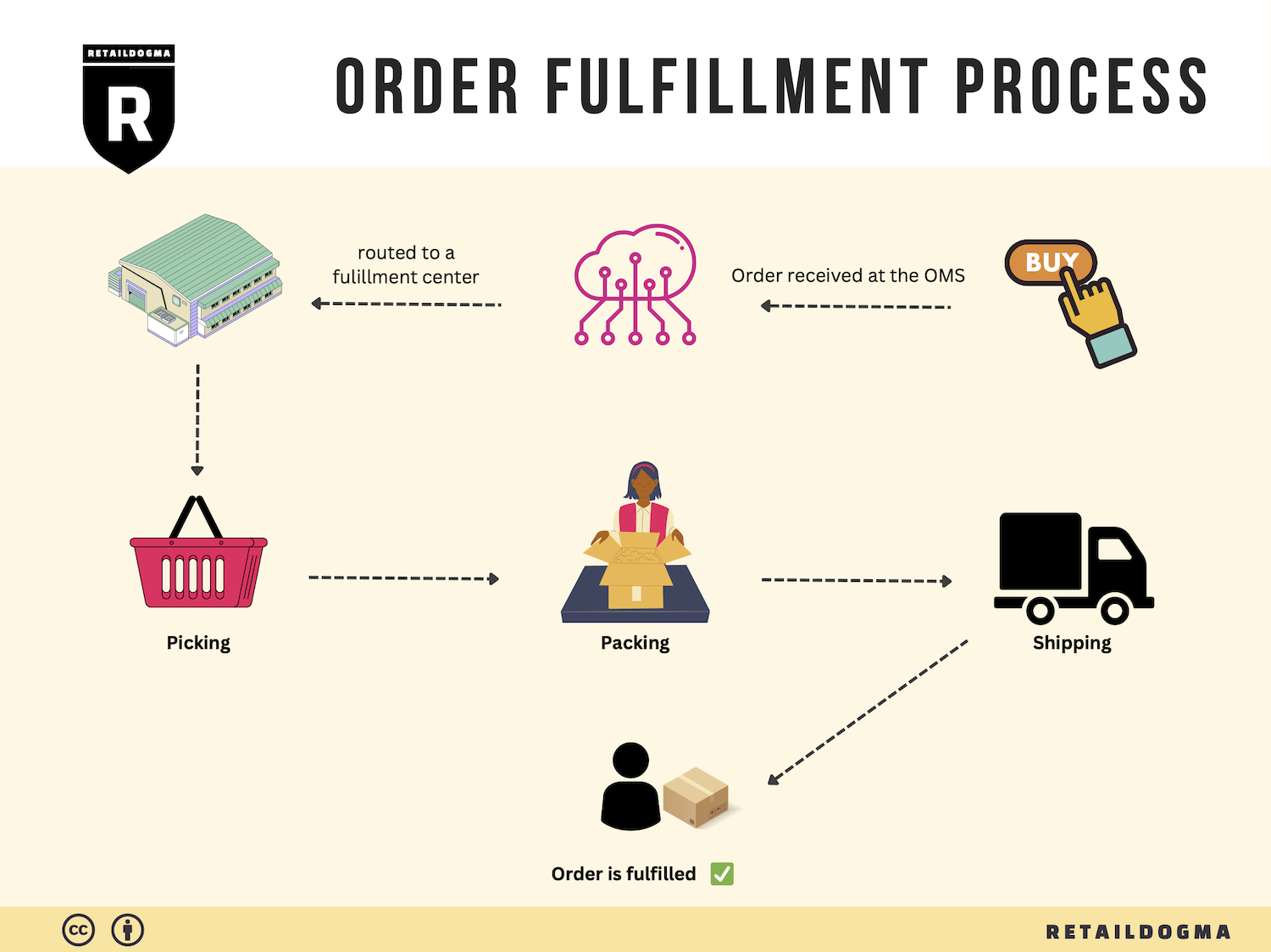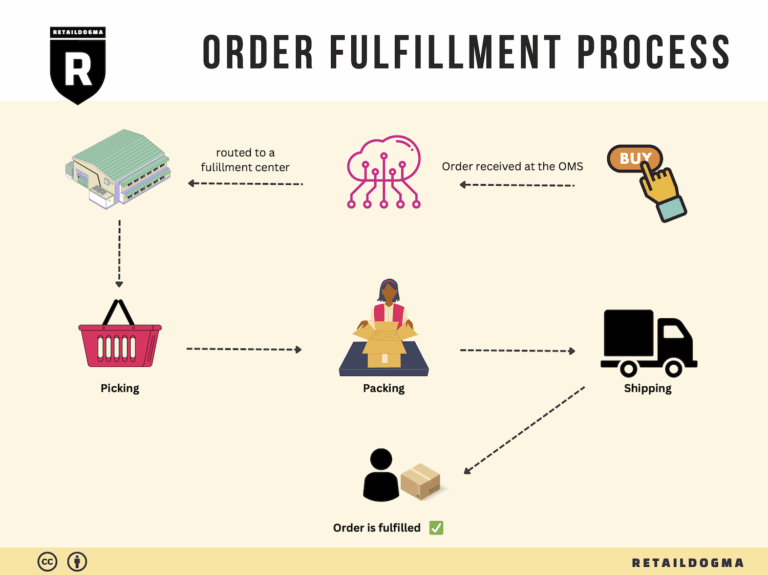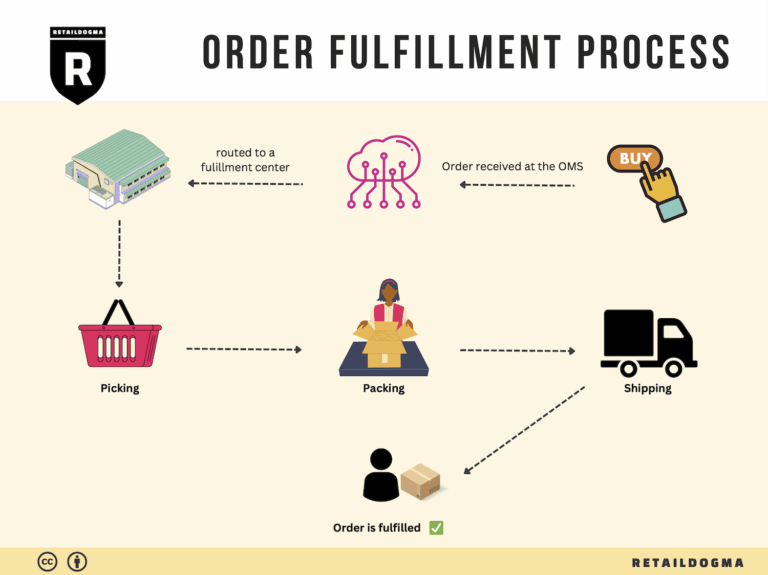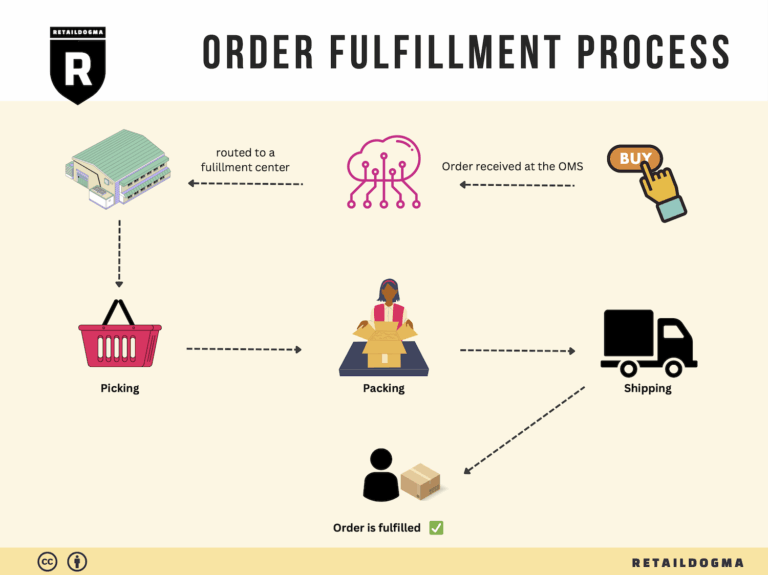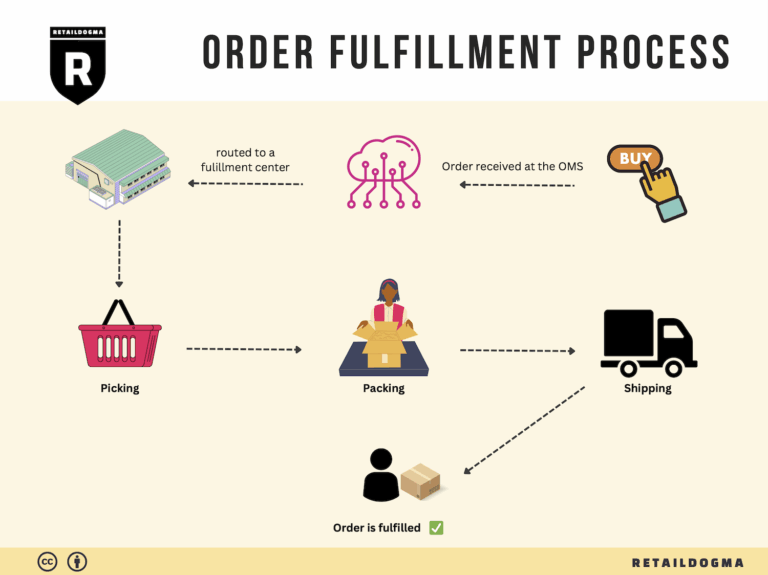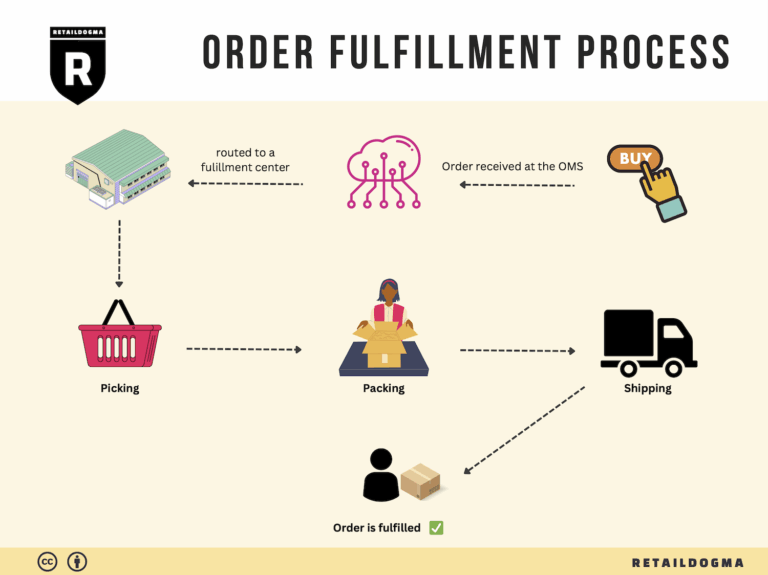What Is A Fulfillment Center? A Complete Guide (2025)
What is E-commerce Fulfillment? An Introduction for Growing Businesses
Running a growing e-commerce business is often a balancing act, where the thrill of expanding your product line can quickly turn into the chaos of managing logistics. As orders start to pour in, many entrepreneurs find themselves overwhelmed with the nitty-gritty of packing and shipping—tasks that can consume valuable time and resources, diverting focus from scaling your business. This is where understanding e-commerce fulfillment becomes crucial.
E-commerce fulfillment is simply the process of getting a product from your inventory to your customer’s doorstep. It encompasses everything from order processing and inventory management to shipping and returns. For many businesses, particularly those in the early stages or those experiencing rapid growth, outsourcing fulfillment can be a game-changer. This guide is designed to demystify the various fulfillment models available today, helping you navigate the complexities of logistics with confidence.
Understanding Fulfillment Models
In this guide, we will explore different fulfillment models, including Third-Party Logistics (3PL), Fulfillment by Amazon (FBA), and more. Each model has its own set of advantages and challenges, and choosing the right one can significantly impact your operational efficiency and customer satisfaction.
Core Fulfillment Services
We will delve into the core services that fulfillment partners typically offer, such as inventory storage, order picking and packing, shipping, and handling returns. Understanding these services will help you identify what your business needs as you scale.
Choosing the Right Partner
Selecting a fulfillment partner is a critical decision that can affect your bottom line. We will provide practical advice on what to look for in a fulfillment partner, including technology integration, shipping capabilities, and customer service.
Pricing Considerations
Finally, we will discuss pricing structures associated with different fulfillment models, helping you make informed financial decisions as you scale your logistics operations.
Empowering Your Business
The goal of this guide is to empower you to make smart, strategic decisions about your logistics. By understanding e-commerce fulfillment, you can streamline your operations, enhance customer experience, and ultimately focus on what you do best—growing your business. Whether you’re just starting or looking to optimize your existing processes, this comprehensive guide will equip you with the knowledge you need to navigate the world of e-commerce fulfillment successfully.
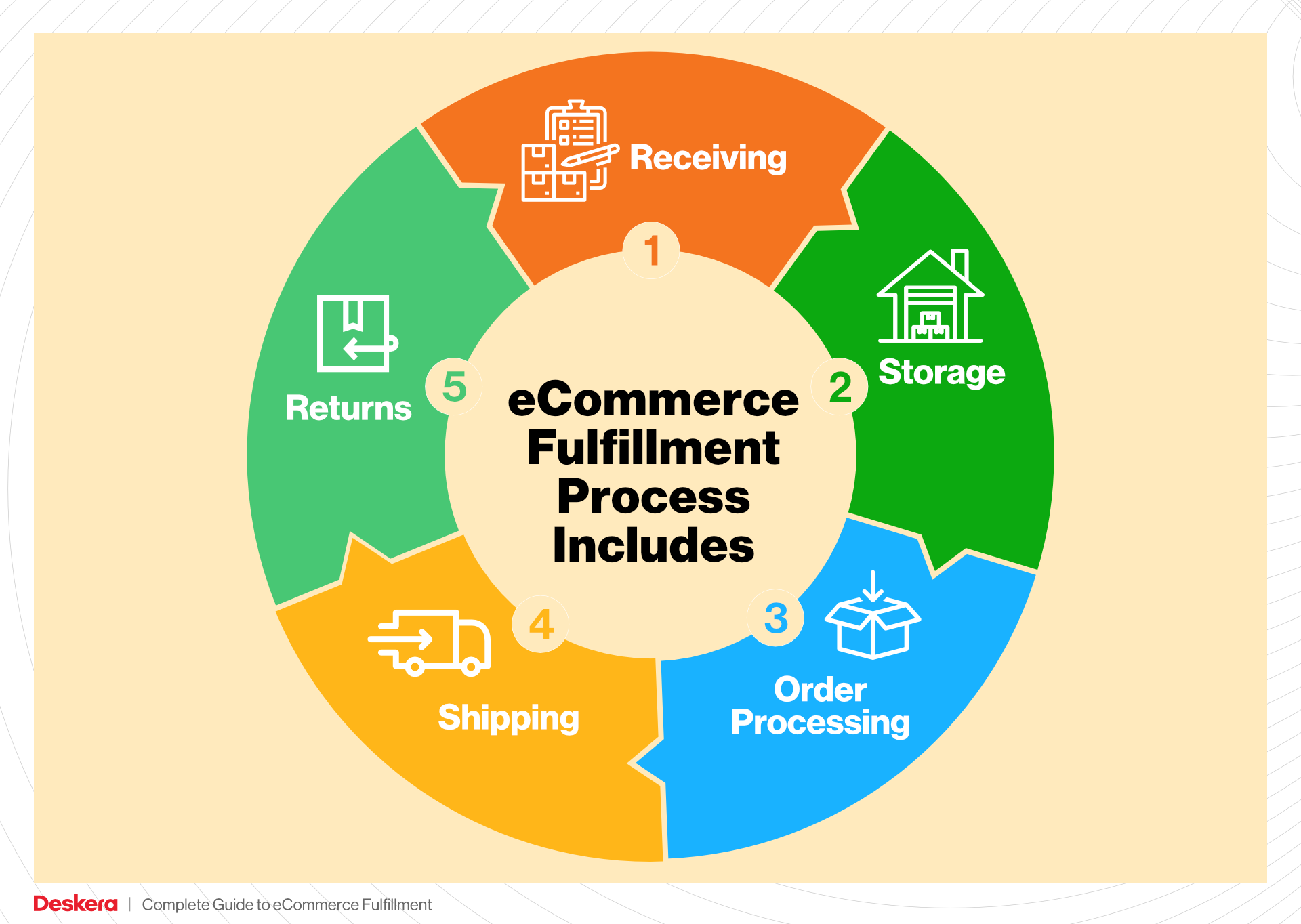
What You’ll Learn In This Guide
- What is E-commerce Fulfillment? An Introduction for Growing Businesses
- The Order Fulfillment Process: From ‘Buy’ Button to Customer’s Door
- Comparing Fulfillment Models: In-House vs. 3PL vs. Dropshipping
- A Deep Dive into Amazon FBA: Pros, Cons, and Who It’s For
- Core Services Offered by Fulfillment Centers
- How to Choose a Fulfillment Partner: A 6-Point Checklist
- Understanding Fulfillment Pricing: A Breakdown of Common Fees
- Frequently Asked Questions (FAQs) about Fulfillment
- Conclusion: Is Outsourcing Fulfillment the Right Move for Your Business?
- Important Disclaimer
The Order Fulfillment Process: From ‘Buy’ Button to Customer’s Door
1. Receiving Inventory
The first step in the order fulfillment process is receiving inventory. This involves the delivery of products from suppliers to the fulfillment center. Upon arrival, the inventory is checked against the purchase order to ensure accuracy in quantity and quality.
Why It’s Important: Proper receiving procedures help prevent discrepancies that could lead to stockouts or overstock situations. An efficient receiving process ensures that the right products are available for order fulfillment, minimizing delays in shipping to customers.
Key Term: SKU (Stock Keeping Unit) – A unique identifier assigned to each product, allowing for easy tracking and management of inventory throughout the fulfillment process.
2. Warehouse Storage
Once inventory is received and verified, it is moved into storage within the fulfillment center. Products are organized in a systematic manner, often categorized by product type, size, or sales velocity, to optimize space and accessibility.
Why It’s Important: Effective warehouse storage maximizes the use of available space and enhances operational efficiency. By strategically placing items, businesses can reduce the time it takes to pick and pack orders, ultimately leading to faster delivery times.
Key Term: FIFO (First In, First Out) – A method of inventory management where the oldest stock is sold first, ensuring freshness and reducing the risk of obsolescence.
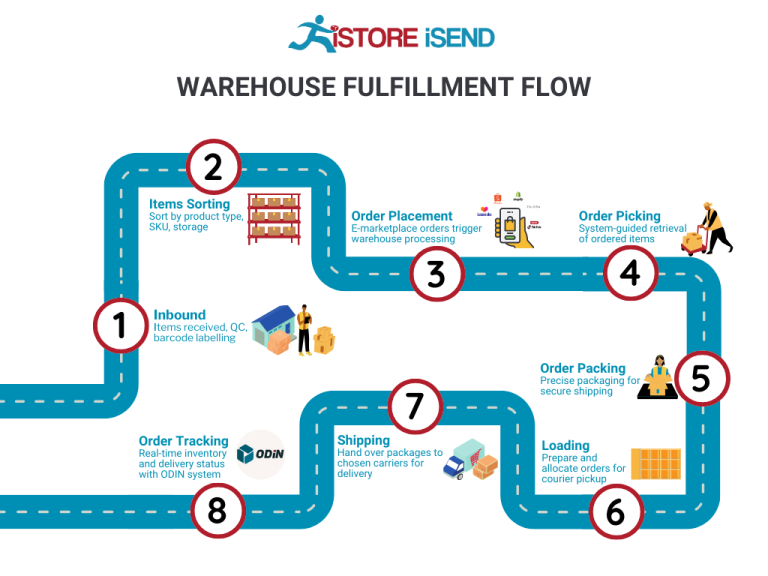
3. Order Picking
When a customer places an order, the next step is order picking. This process involves retrieving the specific items from storage to fulfill the order. Fulfillment centers utilize various methods for picking, including single order picking, batch picking, or wave picking, depending on the volume and complexity of orders.
Why It’s Important: Efficient order picking is crucial for maintaining customer satisfaction and meeting delivery timelines. Errors during picking can lead to incorrect shipments, resulting in returns, refunds, and loss of customer trust.
Key Term: Pick Lists – A document or digital tool that lists the items to be retrieved for an order, often organized by location to streamline the picking process.
4. Order Packing
After the items are picked, they are taken to the packing station. Here, products are carefully packaged for shipment. This may involve selecting appropriate packing materials, applying branding elements, and ensuring that the items are secure to prevent damage during transit.
Why It’s Important: Proper packing is vital for protecting products during shipping and enhancing the customer experience. A well-packaged order not only reduces the likelihood of returns due to damage but also reinforces the brand’s commitment to quality.
Key Term: Packing Slip – A document included in the package that outlines the items contained within, serving as a reference for both the seller and the customer.
5. Shipping & Delivery
The final step in the order fulfillment process is shipping and delivery. Once the order is packed, it is labeled and handed over to a carrier for transportation to the customer. This step involves selecting the most cost-effective and timely shipping options based on the destination and customer preferences.

Why It’s Important: Timely shipping is a critical factor in customer satisfaction. Efficient delivery processes can lead to repeat business, positive reviews, and a strong brand reputation. Additionally, understanding shipping logistics helps businesses manage costs effectively.
Key Term: Last Mile Delivery – The final step of the delivery process where the package is transported from a distribution center to the customer’s doorstep, often considered the most challenging and costly part of the shipping process.
In summary, mastering the order fulfillment process is essential for e-commerce businesses looking to scale their operations effectively. By understanding and optimizing each step—from receiving inventory to ensuring timely delivery—business owners can enhance customer satisfaction, reduce operational costs, and ultimately drive growth in their sales and logistics strategies.
Comparing Fulfillment Models: In-House vs. 3PL vs. Dropshipping
Fulfillment Model Comparison
| Model | Who Handles Inventory | Best For (Business Stage) | Key Advantage | Key Disadvantage |
|---|---|---|---|---|
| In-House Fulfillment | Business owner or staff | Established businesses | Full control over inventory and shipping | High upfront costs and operational complexity |
| Third-Party Logistics (3PL) | 3PL provider | Growing businesses | Reduced logistics burden and access to expertise | Less control over inventory and fulfillment speed |
| Dropshipping | Supplier or manufacturer | Startups and small businesses | Low startup costs and no inventory risk | Lower margins and potential quality control issues |
In-House Fulfillment
In-house fulfillment refers to the process where a business manages its own inventory, storage, and shipping processes. This model is typically suited for established businesses that have the resources and infrastructure to handle logistics internally. The primary advantage of in-house fulfillment is the level of control it provides; businesses can oversee every aspect of their operations, from inventory management to packaging and shipping. This direct oversight can enhance customer satisfaction by ensuring that products are handled according to specific standards.
However, this model comes with significant disadvantages, particularly concerning costs and complexity. Setting up an in-house fulfillment operation requires substantial upfront investment in warehousing, equipment, and staffing. Moreover, as order volumes increase, the operational complexity can escalate, leading to challenges in efficiency, scalability, and resource allocation. Businesses must also stay updated with logistics trends and technology to remain competitive, which can further strain resources.
Third-Party Logistics (3PL)
Third-party logistics (3PL) involves outsourcing fulfillment operations to specialized logistics providers. This model is ideal for growing businesses that seek to streamline their logistics processes without incurring the heavy costs associated with in-house fulfillment. By leveraging a 3PL provider, businesses can reduce their operational burden, gain access to advanced logistics technologies, and benefit from the provider’s expertise in inventory management and shipping.
One of the key advantages of using a 3PL service is the ability to scale operations quickly and efficiently. As order volumes fluctuate, businesses can adjust their logistics needs without the need to invest in additional infrastructure. Additionally, 3PL providers often have established relationships with carriers, which can lead to reduced shipping costs and improved delivery times. However, relying on a 3PL means relinquishing some control over inventory and fulfillment processes, which can lead to potential delays and discrepancies if not managed effectively. Businesses must also ensure clear communication and integration with their 3PL partner to maintain a seamless customer experience.
Dropshipping
Dropshipping is a fulfillment model where businesses sell products without holding any inventory. Instead, when a customer places an order, the business purchases the item from a third-party supplier, who then ships it directly to the customer. This model is particularly attractive for startups and small businesses, as it requires minimal upfront investment and allows entrepreneurs to test products and markets without the risks associated with inventory management.
The primary advantage of dropshipping is the low barrier to entry. Entrepreneurs can launch their e-commerce stores with limited financial risk, as they do not need to invest in inventory or warehousing. This flexibility enables businesses to offer a wide range of products without the financial burden of unsold stock. However, dropshipping also has significant downsides, including lower profit margins and potential quality control issues. Since businesses rely on suppliers for product quality and shipping, any mistakes or delays can negatively impact customer satisfaction and brand reputation. Furthermore, the competition in dropshipping can be intense, leading to challenges in differentiating product offerings and maintaining profitability.
Conclusion
Choosing the right fulfillment model is crucial for e-commerce success, and the best option depends on the unique needs and stage of your business. In-house fulfillment offers control but at a high operational cost. Third-party logistics provide a balance of efficiency and expertise, making them suitable for growing businesses looking to scale. Meanwhile, dropshipping presents a low-risk entry point for startups but comes with its own set of challenges. Understanding these models in depth will help business owners make informed decisions that align with their strategic goals and operational capabilities.
A Deep Dive into Amazon FBA: Pros, Cons, and Who It’s For
Understanding Fulfillment by Amazon (FBA)
Fulfillment by Amazon (FBA) is a logistics service that allows sellers to store their products in Amazon’s fulfillment centers. Amazon then takes care of storage, packaging, shipping, and customer service for these products. This service enables sellers to leverage Amazon’s vast distribution network and customer base, enhancing their sales potential without the burden of managing logistics themselves.
How FBA Works
-
Setting Up an Account: Sellers begin by creating an Amazon seller account and enrolling in the FBA program. This involves selecting the products they wish to sell and preparing them according to Amazon’s packaging and labeling requirements.
-
Shipping Inventory: Once products are prepared, sellers ship their inventory to one or more of Amazon’s fulfillment centers. Amazon provides guidance on how to send inventory, including which fulfillment centers to use based on the seller’s location and product type.
-
Product Listing: Sellers list their products on Amazon, and when a customer places an order, the fulfillment process is initiated.
-
Order Fulfillment: Amazon picks, packs, and ships the products directly to the customer. They also handle customer inquiries, returns, and refunds, allowing sellers to focus on other aspects of their business.
-
Customer Service: Amazon manages all customer service related to FBA orders, which includes handling inquiries and returns, providing a seamless experience for buyers.
-
Payment: Sellers receive payments for their sales, minus Amazon’s fees, which are typically processed every two weeks.
Pros of Using FBA
1. Prime Eligibility
One of the most significant advantages of FBA is that products become eligible for Amazon Prime. This means that Prime members can enjoy free two-day shipping on eligible items, making them more attractive to a large pool of customers. The Prime badge can significantly enhance sales, as it is associated with trust and reliability.
2. Customer Trust and Credibility
Selling through Amazon gives sellers access to Amazon’s trusted platform. Customers often feel more comfortable purchasing items that are fulfilled by Amazon due to their reputation for reliability and customer service. This trust can lead to higher conversion rates and repeat purchases.
3. Multi-Channel Fulfillment
FBA isn’t limited to Amazon sales. Sellers can use FBA to fulfill orders from other sales channels, such as their own websites or other marketplaces. This flexibility allows businesses to streamline their logistics and inventory management across various platforms while benefiting from Amazon’s logistics capabilities.
4. Scalable Operations
FBA allows sellers to scale their operations without the need for significant upfront investment in warehousing or logistics. As sales increase, sellers can easily send more inventory to Amazon’s fulfillment centers without having to manage the complexities of warehousing and shipping themselves.
5. Simplified Returns Management
Amazon handles all returns for FBA orders, making it easier for sellers to manage this often cumbersome aspect of e-commerce. This automated process helps maintain customer satisfaction and reduces the operational load on sellers.
Cons of Using FBA
1. High Fees
FBA comes with various fees that can eat into profits. These include storage fees for keeping inventory in Amazon’s warehouses, fulfillment fees for picking, packing, and shipping products, and additional costs for long-term storage. Sellers must carefully calculate these fees to ensure their pricing remains competitive.
2. Strict Inventory Management Rules
Amazon has strict policies regarding inventory management, including limits on the amount of inventory a seller can send to fulfillment centers. This can lead to stockouts or excess inventory, which can incur additional fees. Sellers must be diligent in tracking their inventory levels and sales velocity to avoid these pitfalls.
3. Commingling Risks
FBA allows for commingled inventory, where products from multiple sellers are stored together. While this can streamline operations, it poses a risk if one seller’s product is defective or damaged. This can lead to negative reviews for all sellers with commingled inventory, affecting reputation and sales.
4. Loss of Control Over Fulfillment
By outsourcing fulfillment to Amazon, sellers lose some control over how their products are handled, packaged, and shipped. This can be a concern for brands that have specific requirements regarding packaging or shipping methods that align with their branding.
5. Dependency on Amazon’s Platform
Using FBA ties a seller’s success closely to Amazon’s platform. Changes in Amazon’s policies, fees, or algorithms can significantly impact a seller’s business, leading to potential risks if they do not diversify their sales channels.
Who is FBA Best For?
Fulfillment by Amazon is best suited for:
-
Small to Medium-Sized Businesses: Companies looking to scale without the overhead of managing their own logistics can benefit greatly from FBA. It allows them to focus on marketing and product development.
-
Brands with Established Products: Sellers with a proven track record of sales can leverage FBA to enhance their visibility and sales potential on Amazon.
-
E-commerce Entrepreneurs: New sellers entering the e-commerce space can use FBA to simplify logistics, allowing them to concentrate on growing their brand rather than managing inventory.
-
Sellers Seeking to Expand: Businesses that want to reach a broader audience and take advantage of Amazon’s massive customer base will find FBA a compelling option.
In conclusion, while Fulfillment by Amazon offers numerous benefits that can help scale a business, sellers must weigh these against the potential downsides, particularly the fees and loss of control over fulfillment. Understanding these dynamics is crucial for making informed decisions about whether FBA is the right choice for your e-commerce strategy.
Core Services Offered by Fulfillment Centers
Inventory Management & Warehousing
Inventory management and warehousing are foundational services provided by fulfillment centers. This involves the systematic control of inventory levels, ensuring that products are stored efficiently and are readily available for order fulfillment. Fulfillment centers utilize advanced inventory management systems that allow e-commerce businesses to track stock levels in real-time, manage reorder points, and analyze inventory turnover rates.
Benefits for E-commerce Businesses:
1. Real-Time Visibility: Businesses gain immediate insight into inventory levels, which helps in making informed decisions about restocking and product launches.
2. Reduced Storage Costs: By leveraging shared warehousing space, e-commerce companies can avoid the overhead costs associated with maintaining their own warehouses.
3. Efficient Space Utilization: Fulfillment centers optimize storage layouts, ensuring that products are stored in a manner that maximizes space and improves accessibility.
4. Inventory Accuracy: Automated tracking reduces the likelihood of human error, ensuring that the inventory data is accurate, which is critical for maintaining customer trust and satisfaction.
Pick and Pack Services
Pick and pack services are critical components of the order fulfillment process. Once an order is placed, fulfillment centers are responsible for picking the correct items from their inventory and packing them for shipment. This process can vary from basic to highly customized, depending on the needs of the e-commerce business.
Benefits for E-commerce Businesses:
1. Speed and Efficiency: Fulfillment centers employ trained staff and technology to ensure that orders are picked and packed quickly, leading to faster delivery times. This speed can significantly enhance customer satisfaction and loyalty.
2. Quality Control: Many fulfillment centers implement quality checks during the packing process to ensure that the correct items are shipped and that they meet the company’s standards. This reduces returns due to errors and enhances the brand’s reputation.
3. Scalability: As e-commerce businesses grow, their order volumes can fluctuate. Fulfillment centers can scale their pick and pack operations up or down, allowing businesses to adapt to changing demand without additional overhead.
4. Customized Packaging Options: Fulfillment centers often offer various packaging solutions, which can be tailored to align with a brand’s identity. Custom packaging enhances the unboxing experience, potentially leading to repeat purchases.
Kitting and Assembly
Kitting and assembly services are designed to create bundled products or kits that are sold together. This service is particularly useful for businesses that offer products that complement each other, such as a skincare regimen or a set of kitchen tools. Fulfillment centers can assemble these kits before shipping them to customers.
Benefits for E-commerce Businesses:
1. Enhanced Product Offering: Kitting allows businesses to offer unique product combinations that can increase average order value and appeal to customers looking for convenience.
2. Streamlined Operations: By outsourcing the kitting process to fulfillment centers, businesses can focus on core activities such as marketing and product development, rather than on labor-intensive assembly work.
3. Inventory Efficiency: Kitting can help manage inventory more effectively by reducing the number of individual SKUs that need to be tracked, simplifying inventory management.
4. Improved Customer Experience: Offering pre-assembled kits can enhance the shopping experience, making it easier for customers to purchase complementary items without having to select each product individually.
Returns Management (Reverse Logistics)
Returns management, or reverse logistics, involves handling product returns in an efficient and customer-friendly manner. Fulfillment centers often provide services to manage the entire returns process, from receiving returned items to restocking them or issuing refunds.
Benefits for E-commerce Businesses:
1. Improved Customer Satisfaction: A hassle-free returns process can enhance customer trust and loyalty. Customers are more likely to make purchases if they know they can easily return items that don’t meet their expectations.
2. Streamlined Operations: By outsourcing returns management, businesses can reduce the burden on their internal teams, allowing them to focus on growth and customer engagement rather than handling returns.
3. Data Insights: Fulfillment centers can provide valuable data on return reasons and trends, allowing businesses to make informed decisions about product quality and customer preferences.
4. Cost Savings: Efficient returns management can minimize losses associated with returned products. Fulfillment centers can quickly assess returned items and determine whether they can be restocked, repaired, or need to be discarded, thus optimizing recovery processes.
In summary, the core services offered by fulfillment centers—inventory management and warehousing, pick and pack services, kitting and assembly, and returns management—are essential for e-commerce businesses looking to scale efficiently. By leveraging these services, businesses can enhance their operational efficiency, improve customer satisfaction, and ultimately drive sales growth.
How to Choose a Fulfillment Partner: A 6-Point Checklist
Location & Warehouse Network
Importance:
The geographical location of your fulfillment partner’s warehouses can significantly impact shipping times and costs. A fulfillment partner with strategically placed warehouses can reduce shipping distances, resulting in faster delivery to your customers and lower shipping expenses.
Questions to Ask:
– Where are your warehouses located, and how do these locations serve my target market?
– Do you have a network of warehouses that can cover multiple regions or countries?
– How do you handle shipping and logistics in less accessible areas?
Technology & Integrations
Importance:
In today’s digital landscape, the technology used by your fulfillment partner is critical. A partner with advanced systems can streamline operations, provide real-time inventory tracking, and integrate seamlessly with your existing e-commerce platforms, which enhances efficiency and visibility.
Questions to Ask:
– What technology do you use for inventory management, order processing, and tracking?
– Can your system integrate with my e-commerce platform (e.g., Shopify, Amazon, etc.)?
– Do you offer an API for custom integrations or additional features?
Specializations (e.g., Cold Storage, Oversized Items)
Importance:
Depending on your product line, certain specializations may be necessary. For example, if you sell perishable goods, a partner with cold storage capabilities is essential. Similarly, if you deal with oversized or unique items, ensure your fulfillment partner can accommodate these needs.
Questions to Ask:
– Do you have specific facilities for handling specialized products, such as cold storage or oversized items?
– What processes do you have in place to ensure the safe handling and storage of my products?
– Can you provide examples of clients with similar product needs and how you’ve successfully fulfilled their requirements?
Scalability & Capacity
Importance:
As your business grows, your fulfillment needs will likely evolve. It’s crucial to partner with a fulfillment provider that can scale with your business, whether that means handling larger volumes during peak seasons or expanding into new markets.
Questions to Ask:
– How do you manage peak season demands, and what capacity do you have for scalability?
– What are your policies for scaling operations if my sales increase significantly?
– Can you provide historical data on your capacity and how you’ve managed growth for other clients?
Pricing and Contracts
Importance:
Understanding the pricing structure and contract terms is vital for maintaining profitability. Look for transparency in pricing and be wary of hidden fees. It’s also important to know the terms of the contract, including any exit clauses.
Questions to Ask:
– What is your pricing structure? Are there any hidden fees I should be aware of?
– Can you provide a detailed breakdown of costs associated with storage, picking, packing, and shipping?
– What are the terms of the contract, and is there flexibility if my needs change?
Customer Support & Reviews
Importance:
Reliable customer support can make or break your relationship with a fulfillment partner. Efficient and responsive support can quickly resolve issues, ensuring minimal disruption to your operations. Additionally, researching reviews and testimonials can provide insights into the partner’s reliability and service quality.
Questions to Ask:
– What kind of customer support do you offer, and what are your hours of operation?
– How quickly can I expect a response to inquiries or issues that arise?
– Can you provide references or case studies from current or past clients that highlight your service quality?
Conclusion
Choosing the right fulfillment partner is a crucial decision that can significantly influence your e-commerce business’s efficiency, customer satisfaction, and growth potential. By considering factors such as location, technology, specialization, scalability, pricing, and customer support, you can make an informed decision that aligns with your business goals. Take the time to thoroughly vet potential partners, ask the right questions, and ensure that they can meet your specific needs as you scale your operations.
Understanding Fulfillment Pricing: A Breakdown of Common Fees
Initial Setup Fees
When starting with a fulfillment service like Shein Fulfillment, many providers will charge an initial setup fee. This fee typically covers the administrative costs associated with onboarding your business into their system. It may include setting up your account, integrating your inventory management system, and configuring your shipping preferences.
The cost of initial setup fees can vary significantly depending on the complexity of your operations and the fulfillment provider’s pricing model. Some providers may offer a flat fee, while others might charge based on the volume of products you plan to store and ship. For businesses with intricate product lines or custom requirements, these fees can range from a few hundred to several thousand dollars.
Receiving Fees
Receiving fees are charged each time your inventory arrives at the fulfillment center. These fees compensate the provider for the labor and resources required to unload, inspect, and store your products. The calculation of receiving fees often depends on the volume of goods received, typically expressed in terms of weight or unit count.
For example, some fulfillment centers may charge a per-pallet fee, while others might implement a tiered pricing structure based on the total weight of the shipment. If you regularly ship large quantities, understanding these costs is crucial, as they can accumulate quickly and impact your overall fulfillment budget.
Storage Fees (per pallet/bin)
Storage fees are a recurring expense that e-commerce businesses need to consider when partnering with a fulfillment service. These fees are charged for the space your inventory occupies in the fulfillment center.
Storage fees can be calculated in different ways, such as per pallet or per bin. A pallet is a standard unit of measure for storing goods, while a bin refers to smaller storage containers within the warehouse. Pricing structures may vary based on the provider, with some charging a flat monthly fee per pallet, while others might offer a tiered pricing model that decreases the rate as you store more pallets.
It’s essential to monitor your inventory turnover rate to manage storage costs effectively. If you have slow-moving inventory, you may incur higher storage fees over time, which can erode your profit margins.
Pick & Pack Fees (per item/order)
Pick and pack fees are charges for the labor involved in retrieving items from storage and preparing them for shipment. This process includes picking the correct items, packing them securely, and labeling them for delivery.
These fees can be calculated on a per-item or per-order basis. For instance, some fulfillment services may charge a flat rate for picking a single item, while others might implement a fee structure based on the total number of items in an order. If your business frequently ships multi-item orders, understanding how these fees are structured can help you optimize your order fulfillment strategy and improve your bottom line.
Shipping Fees
Shipping fees represent one of the most significant costs in the fulfillment process. These fees cover the transportation of goods from the fulfillment center to the customer’s address.
Shipping costs can vary based on several factors, including package weight, dimensions, shipping speed, and destination. Fulfillment providers often have negotiated rates with carriers, which can lead to cost savings for your business. However, it’s crucial to understand how these fees are calculated, as shipping costs can fluctuate based on seasonal demand and changes in carrier pricing.
Many fulfillment services provide a shipping calculator that allows you to estimate shipping costs based on different scenarios, helping you to budget more accurately.
Tips for Getting an Accurate Quote
-
Clarify Your Needs: Before seeking quotes, clearly define your business’s fulfillment requirements, including expected order volumes, product dimensions, and shipping destinations.
-
Request Detailed Breakdown: Always ask for a detailed breakdown of all potential fees. This includes initial setup, receiving, storage, pick & pack, and shipping fees. Understanding each component will give you a clearer picture of your total fulfillment costs.
-
Compare Multiple Providers: Don’t settle for the first quote you receive. Compare at least three different fulfillment providers to ensure you’re getting competitive pricing and services that align with your business needs.
-
Inquire About Discounts: Some fulfillment providers offer discounts for higher volumes or longer-term contracts. Be sure to ask about any possible savings opportunities that could reduce your overall costs.
-
Review Contracts Carefully: Always review the terms of service and pricing structure in any contracts before signing. Pay attention to any hidden fees or clauses that could impact your total costs.
By understanding these common fulfillment pricing models and considering these tips, you can make informed decisions that will help optimize your fulfillment strategy and ultimately support your business growth.
Frequently Asked Questions (FAQs) about Fulfillment
1. What is Shein Fulfillment Service (SFS)?
Shein Fulfillment Service (SFS) is a logistics solution that allows third-party sellers on the Shein platform to store, process, and ship their products using Shein’s fulfillment centers. This service alleviates sellers from managing inventory, packaging, and shipping, enabling them to focus on growing their business.
2. How does Shein Fulfillment improve my shipping efficiency?
By utilizing Shein’s extensive network of fulfillment centers, including locations in the US, Europe, and Asia, sellers can benefit from reduced shipping times and costs. Products stored in these centers are readily available for fast order processing, leading to improved delivery speed and customer satisfaction.
3. What are the benefits of using Shein Fulfillment?
Key benefits include bulk shipping for efficient storage, automated order fulfillment, real-time inventory tracking, priority product placement within the marketplace, and hassle-free returns and exchanges. Additionally, it lowers operational costs by eliminating the need for dedicated warehousing and logistics management.
4. Who is eligible to use Shein Fulfillment?
To qualify for Shein Fulfillment, sellers must be professional vendors with a minimum annual revenue of $5 million, manage domestic US-based operations, and have the capability to ship directly to US customers.
5. What is the difference between a warehouse and a fulfillment center?
A warehouse primarily serves as a storage facility for goods, while a fulfillment center is designed specifically for processing orders and shipping products to customers. Fulfillment centers offer additional services such as inventory management, order processing, and returns handling, making them ideal for e-commerce businesses.
6. What is a 3PL (Third-Party Logistics)?
A 3PL provider offers outsourced logistics services, including warehousing, inventory management, and shipping. These providers help businesses streamline their supply chain operations, allowing them to focus on core activities such as product development and marketing.
7. How much do fulfillment services cost?
Fulfillment service costs vary based on factors such as storage space, order volume, and shipping rates. While Shein’s specific pricing is not publicly disclosed, it typically includes fees for storage, picking and packing, and shipping. Sellers should compare different fulfillment options to find the best fit for their budget.
8. How do I get started with Shein Fulfillment?
To begin with Shein Fulfillment, you must apply to become a seller on the Shein platform. Once accepted, you can enlist your products, choose your preferred fulfillment method, and start shipping your goods to Shein’s fulfillment centers.
9. How does Shein handle returns and exchanges?
Shein Fulfillment manages the entire returns process for sellers. This includes receiving returned products, restocking them, and processing refunds or exchanges, which helps maintain customer satisfaction and reduces the operational burden on sellers.
10. How quickly will I get paid for orders processed through Shein Fulfillment?
Shein operates on a one-week payment cycle, authorizing payments every Monday. Once authorized, payments are typically processed within one to three business days, ensuring sellers receive their earnings promptly.
Conclusion: Is Outsourcing Fulfillment the Right Move for Your Business?
Evaluating the Benefits of Outsourcing Fulfillment
Outsourcing fulfillment can be a transformative decision for e-commerce businesses aiming for growth and efficiency. One of the most significant advantages is the time savings it offers. By delegating logistics, inventory management, and shipping to a specialized partner like Shein Fulfillment, business owners can redirect their focus toward core activities such as product development, marketing strategies, and customer engagement. This shift in focus can lead to enhanced innovation and an improved customer experience.
Scalability is another critical benefit of utilizing a fulfillment service. As your business grows, so do your operational demands. A reliable fulfillment partner can seamlessly accommodate increased order volumes without the need for substantial investments in warehousing or staffing. This scalability allows businesses to expand their reach and explore new markets while maintaining operational efficiency.
Moreover, partnering with an experienced fulfillment service provides access to industry expertise and advanced technology. These partners often have sophisticated systems for inventory tracking, order processing, and logistics management, which can significantly reduce errors and improve delivery times. This expertise not only enhances customer satisfaction but also builds brand credibility in a competitive marketplace.
However, the success of outsourcing fulfillment hinges on selecting the right partner. It’s crucial to evaluate potential fulfillment services based on their capabilities, geographic reach, and customer support.
As you consider these factors, take a moment to audit your current shipping and fulfillment processes. Are they meeting your business needs effectively? If you find gaps or inefficiencies, it may be time to explore the benefits of a fulfillment partnership. Embrace the opportunity to streamline operations and position your business for sustainable growth.
Important Disclaimer
⚠️ Important Disclaimer
The information in this guide is for educational purposes. Fulfillment services, pricing, and platform features change frequently. Always conduct your own due diligence and consult with providers directly before making business decisions.
